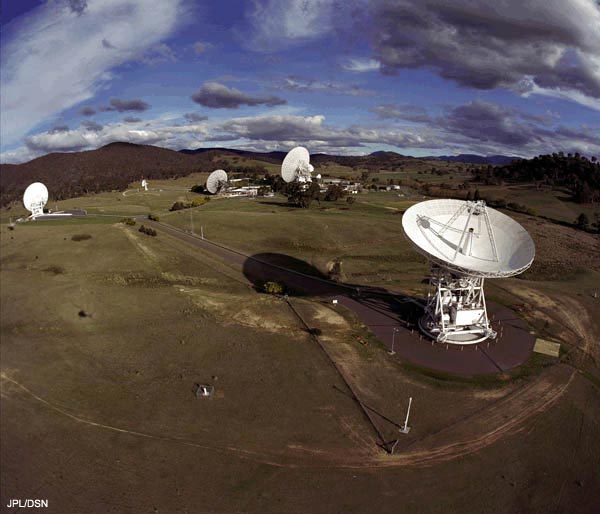Send ET a Text Message From Earth

Here?s atruly long-distance message?one aimed more than 20 light-years away.
A new Website in Australia is gathering text messages from around the world, all to bebeamed to a distant alien planet calledGliese 581d.
The clockis ticking to submit text messages of no longer than 160 characters ? perhaps asignal that extraterrestrial life may have a case of attention deficitdisorder. The project - called ?Hello From Earth? -(http://www.HelloFromEarth.net) ends Aug. 24.
Once thecommuniqu?s are amassed, they will be transmitted from NASA?s Canberra DeepSpace Communication Complex at Tidbinbilla.
Thedispatched messages will join other ?outworldly? attempts to reachout and touch ET, such as Pioneers 10 and 11 launched in the 1970s, each carriedsmall metal plaques identifying their time and place of origin for the benefitof any other spacefarers that might find them in the distant future.
Followingthe Pioneer spacecraft, NASA?s Voyager 1 and 2 were both imbued with a moreambitious message, intended to communicate a story of our world toextraterrestrials. Those Voyager probes are toting a phonograph record - agold-plated copper disk containing sounds and images selected to portray thediversity of life and culture on Earth.
Just lastyear, NASA broadcast the music of theBeatles to Polaris, the North Star. For this, the space agency used the210-foot (64-meter) Deep Space Network antenna near Madrid, Spain. And yearsbefore that, Jamaican musician Bob Marley and his reggae rhythms were sentspaceward via a private venture called Cosmic Call.
Get the Space.com Newsletter
Breaking space news, the latest updates on rocket launches, skywatching events and more!
ET-mail
The ?HelloFrom Earth? site is a National Science Week initiative of the Australianscience magazine, Cosmos. The project is also a salute to the InternationalYear of Astronomy. Additional support for the undertaking includes thatcountry?s Commonwealth Scientific and Industrial Research Organization, NASA,and the Search for Extraterrestrial Intelligence (SETI) Post-DetectionCommittee of the International Academy of Astronautics.
Kick-startingthe initiative, Australian Senator Kim Carr, Minister for Innovation, Industry,Science and Research, entered the first message:
?Hello fromAustralia on the planet we call Earth. These messages express our people?sdreams for the future. We want to share those dreams with you.?
Othere-mails are pouring in, such as this one from Santiago, Chile:
?We?retrying to get over wars [on] our planet, but greed is greater that our dreams.Lots of us know that this is wrong and won?t give up! Hugs from little blue.?
From Ponce,Puerto Rico:
?I should bealive when you get this, come find me I have a lot of questions to ask!?
And fromone enterprising soul in Liege, Belgium:
?Hi ET!We're a company?looking to extend our market?any opportunity to do somebusiness with you? Special price for you!?
Conditionsfor life
The planeton the receiving end of all this radio waving ? Gliese 581d ? is eight timesthe size of Earth and some 20.3 light-years away. That exoplanet was discoveredin April 2007. Because of its size, thefar-away world is labeled as a ?Super Earth.?
Indiscussing the website, Cosmos editor, Wilson da Silva, points out: ?We don?tknow if there?s life on Gliese 581d and we don?t even know if there?s a technicalcivilization capable of detecting our signal. But we do know that it might havethe conditions for life. And as soon as the conditions for life existed onEarth, life emerged.?
Da Silva addsthat even under stellar express conditions, the signal won?t arrive untilaround December 2029.
?And thequestion is?will we get a reply? No one knows?but why don?t we send a messageand find out?? adds Jacqui Hayes, assistant editor for Cosmos magazine.
If you wantto jump onto the bandwidth wagon, you can send your text message to anotherworld by going to: http://www.HelloFromEarth.net
- Video - Figure the Odds of ET
- Writing for an Extraterrestrial Audience
- Top 10 Most Intriguing Extrasolar Planets
LeonardDavid has been reporting on the space industry for more than four decades. Heis past editor-in-chief of the National Space Society's Ad Astra and SpaceWorld magazines and has written for SPACE.com since 1999.
Join our Space Forums to keep talking space on the latest missions, night sky and more! And if you have a news tip, correction or comment, let us know at: community@space.com.

Leonard David is an award-winning space journalist who has been reporting on space activities for more than 50 years. Currently writing as Space.com's Space Insider Columnist among his other projects, Leonard has authored numerous books on space exploration, Mars missions and more, with his latest being "Moon Rush: The New Space Race" published in 2019 by National Geographic. He also wrote "Mars: Our Future on the Red Planet" released in 2016 by National Geographic. Leonard has served as a correspondent for SpaceNews, Scientific American and Aerospace America for the AIAA. He has received many awards, including the first Ordway Award for Sustained Excellence in Spaceflight History in 2015 at the AAS Wernher von Braun Memorial Symposium. You can find out Leonard's latest project at his website and on Twitter.









